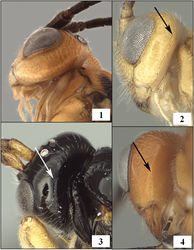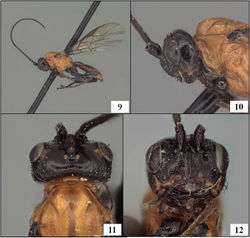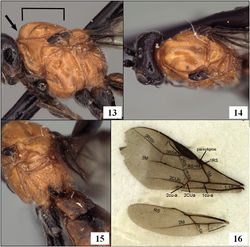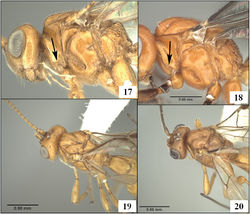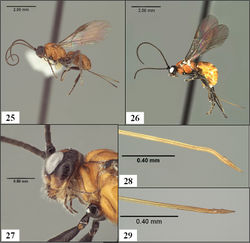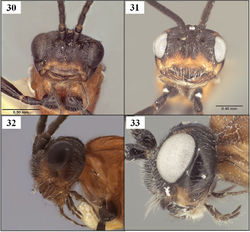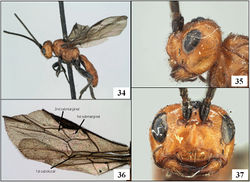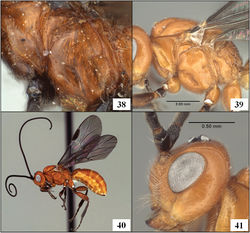Diachasmimorpha
| Notice: | This page is derived from the original publication listed below, whose author(s) should always be credited. Further contributors may edit and improve the content of this page and, consequently, need to be credited as well (see page history). Any assessment of factual correctness requires a careful review of the original article as well as of subsequent contributions.
If you are uncertain whether your planned contribution is correct or not, we suggest that you use the associated discussion page instead of editing the page directly. This page should be cited as follows (rationale):
Citation formats to copy and paste
BibTeX: @article{Wharton2012ZooKeys243, RIS/ Endnote: TY - JOUR Wikipedia/ Citizendium: <ref name="Wharton2012ZooKeys243">{{Citation See also the citation download page at the journal. |
Ordo: Hymenoptera
Familia: Braconidae
Name
Diachasmimorpha Viereck – Wikispecies link – Pensoft Profile
- Diachasmimorpha Viereck, 1913: 641. Type species: Diachasmimorpha comperei Viereck, 1913 [a junior subjective synonym of Diachasmimorpha longicaudata (Ashmead, 1905)]. Monobasic and original designation.
- Biosteres (Parasteres) Fischer, 1967a: 3. Type species: Biosteres (Parasteres) acidusae Fischer, 1967a [a junior subjective synonym of Diachasmimorpha tryoni (Cameron, 1911)]. Original designation.
- Parasteres: Fischer 1971[1]: 33 (change in rank). Synonymized under Biosteres by Wharton and Marsh (1978[2]:154) and under Diachasmimorpha by Wharton (1987a[3]: 62).
Diagnosis
Mandible without basal lobe ventrally. Labrum concealed. Occipital carina broadly absent dorsally, present or absent laterally. Propleuron ventral-laterally without oblique carina. Notauli deep, unsculptured or nearly so, well developed anteriorly, varying posteriorly from absent to deep and complete to midpit; midpit always present. Fore wing stigma short, broad, discrete posteriorly, r1 arising at or distad its midpoint; second submarginal cell short; m-cu arising from second submarginal cell. Hind wing RS absent basally, sometimes present as a weakly pigmented crease distally; 2M distinctly pigmented nearly to wing margin; m-cu present, well-developed. Dorsope absent.
The species of Diachasmimorpha are most readily recognized by the pattern of fore and hind wing venation (Figs 9, 16) in combination with the concealed labrum (Fig. 12), unsculptured notauli (Figs 11, 14, 19, 20), and lack of oblique carina on the propleuron (Fig. 23). The species of Doryctobracon Enderlein, endemic to the New World, are similar but have the fore wing m-cu interstitial or arising from the first submarginal cell and the labrum is partially exposed. Fopius Wharton, an Old World genus with species that have been introduced to the New World, is also similar. The species of Fopius differ by the presence of completely sculptured notauli and the presence of an oblique carina on the propleuron (Fig. 24).
Remarks
Both New and Old World species groups of Diachasmimorpha occur in Mexico. Diachasmimorpha longicaudata (Ashmead) and Diachasmimorpha tryoni, both representatives of the Old World longicaudata species group (Wharton 1997[4]), were established in various parts of Mexico during biological control programs directed against tephritid pests primarily in the genus Anastrepha. Females of the Old World species are readily distinguished from New World Diachasmimorpha because of the sinuate ovipositor (Fig. 28). The notauli are also more deeply incised posteriorly in the longicaudata species group (Fig. 19, in contrast to Fig. 20), which facilitates identification of males in biological control and other tephritid pest management programs. The name Parasteres continues to be used by some authors, for example as a subgenus of Diachasmimorpha (Yu et al. 2012[5]), but we continue to treat Diachasmimorpha tryoni and Diachasmimorpha longicaudata in the same species group based in part on ovipositor morphology. We therefore do not treat Parasteres as valid, nor do we recognize subgenera under Diachasmimorpha at this time.
New World species have previously been referred to as the mexicana species group (Wharton 1997[4]), a use we continue here. Wharton (1997)[4] noted, however, that there were two subgroups distinguished in part on the basis of relative loss of the occipital carina. Further examination and discovery of additional species provides support for the two subgroups. One of these subgroups consists of Diachasmimorpha juglandis (Muesebeck), Diachasmimorpha mellea (Gahan), and Diachasmimorpha sublaevis (Wharton). The occipital carina is generally better developed in this subgroup (usually readily visible laterally as in Fig. 2), the wings are hyaline, and the body is yellowish. As in the longicaudata species group, the anterior margin of the pronotum ventral-laterally is sharply excavated (Fig. 17). The second subgroup contains Diachasmimorpha mexicana (Cameron), Diachasmimorpha sanguinea (Ashmead), Diachasmimorpha hildagensis (Fischer), new combination, and the new species described below. In all of these species, the occipital carina is greatly reduced, present only as a short spur ventrally near the mandible (maximum extent shown in Fig. 4). These species also have infumate wings (Fig. 16) and the body tends to be orange rather than yellow. The anterior margin of the pronotum ventral-laterally is also more sinuate than abruptly excavated (Fig. 18). Detailed diagnoses are provided below for the three previously described species in this second subgroup, to facilitate comparison with the newly described species.
Key to species of Diachasmimorpha known from U.S. and Mexico
Taxon Treatment
- Wharton, R; Ward, L; Miko, I; 2012: New neotropical species of Opiinae (Hymenoptera, Braconidae) reared from fruit-infesting and leaf-mining Tephritidae (Diptera) with comments on the Diachasmimorpha mexicana species group and the genera Lorenzopius and Tubiformopius ZooKeys, 243: 27-82. doi
Other References
- ↑ Fischer M (1971) Index of Entomophagous Insects. Hymenoptera Braconidae. World Opiinae. Le François, Paris, 189 pp.
- ↑ Wharton R, Marsh P (1978) New World Opiinae (Hymenoptera: Braconidae) parasitic on Tephritidae (Diptera). Journal of the Washington Academy of Sciences 68: 147-167.
- ↑ Wharton R (1987a) Changes in nomenclature and classification of some opiine Braconidae (Hymenoptera). Proceedings of the Entomological Society of Washington 89: 61-73.
- ↑ 4.0 4.1 4.2 Wharton R (1997) Generic relationships of opiine Braconidae (Hymenoptera) parasitic on fruit-infesting Tephritidae (Diptera). Contributions of the American Entomological Institute 30: 1-53.
- ↑ Yu D, Van Achterberg C, Horstmann K (2012) Taxapad 2012 – World Ichneumonoidea 2011. Taxonomy, biology, morphology and distribution. On USB Flash http://drive.www.taxapad.com, Ontario.
Images
|
